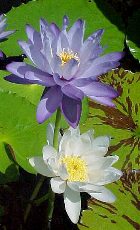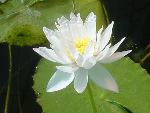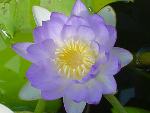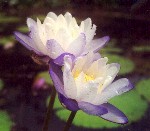When Walter Pagels and I first collected the Normanton waterlilies,
we believed that they were Nymphaea gigantea. Dr Barre
Hellquist who has an extensive knowledge on Australian waterlily
species was skeptical that they were N. gigantea. His
records showed that N. gigantea did not occur as far north
as Normanton. After 18 months of trying to key them out as an
existing species, I now believe that these plants belong to a
new species.
Native Australian waterlilies belong to the Nymphaea subgenus
of Anecphya. This can be divided into two distinct subgroups,
that I will define as the gigantea subgroup and the violacea
subgroup.
|
Gigantea Subgroup: N. gigantea, N. macrosperma N.
immutabilis and N. atrans
1: A noticeable space between the stamens and the petals.
2: Spines on the edges of the leaves
3: No scent or very faint scent
4: Large seeds
|

N. gigantea (blue) and
gigantea 'Albert de Lestang'
Kit Knotts Photo |
|
Violacea Subgroup. N. violacea, N. hastifolia
and N. ellenae
1: No space between the stamens and the petals.
2: No spines on the edges of the leaves
3: A strong fragrant scent
4: Very small seeds
|

The Normanton lilies
Andre Leu Photo |

N. gigantea 'Albert de Lestang'
William Phillips Photo |

N. violacea
William Phillips Photo |
|
The Normanton lily species belongs in the gigantea subgroup
because it clearly possesses the first three characteristics
of that group. Even though it has small seeds they are still
larger than the species in the violacea subgroup. This
rules out N. violacea, N. hastifolia and N. ellenae.
The Normanton lily has the following differences from all
the gigantea subgroup species.
1: It has significantly smaller seeds than any of the gigantea
subgroup species.
2: The new leaves are red. Most of the new leaves of all gigantea
subgroup species are green. Some of the pink flowered forms have
red new leaves.
3: The fact that some Normanton lilies have the ability to flower
24 hours a day is also an important difference.
|
|
There are also individual differences from the four gigantea
subgroup species.
Dr. Barre Hellquist sent tissue samples of Nymphaea
'Andre Leu' (one of the Normanton collection) to Dr. Thomas Borsch
in Germany. Preliminary results show that the chloroplast genome
fragment analyzed is identical with N. macrosperma. It
may be a sister species or a hybrid with it. The maternal parent
could have provided the chloroplast genome. This will be further
clarified when the DNA of nucleus and the mitochodria have been
analysed to find other characteristics.
However, it does not fit N. macrosperma because:
N. macrosperma has the largest seeds of all the Anecphya
- hence its name. Macrosperma is Latin for 'large seed'. The
Normanton seeds are small.
The petal count is greater. N. macrosperma possesses the
fewest petals of this group, with up to 20 petals. The Normanton
lilies can have over 30 petals.
N. macrosperma has acute tipped petals whereas the
Normanton flowers have obtuse tipped petals.
The Normanton lilies have long filaments like N. gigantea
and N. immutabalis rather than the 5mm filaments of N.
macrosperma.
|

N. 'Andre Leu'
William Phillips Photo

N. macrosperma
Barre Hellquist Photo |
|
It does not fit N. atrans because:
The main characteristic that distinguishes N. atrans
as a species from all other lilies are flowers with blue outer
petals, that change to a deep pink over several days. The Normanton
lilies have consistent petal colors that do not fade, change
or fade very slightly. N. atrans is reputed to stay open
24 hours a day, however this has not been properly verified.
|

N. atrans
Barre Hellquist Photo |
|
It does not fit N. immutabilis because:
The shape of the flower is very different. N. immutabilis
and its very close relative N. atrans have cup shaped
flowers, with the petals staying more upright than the other
species. The Normanton lily has flowers with petals that open
more horizontally than these two species.
Most N. immutabilis varieties have blue outer petals
and white inner petals. In most cases except for rare pure white
or pure blue flowers there is a difference in color between outer
and inner petals. The Normanton group usually has no color variation
between outer and inner petals.
|

N. immutabilis
Andre Leu Photo |
|
The Normanton plants have the closest affinities with N. gigantea.
However the significant differences are:
The flowers fade slightly. The flowers of N. gigantea
noticeably fade as they age.
The flowers stay open longer, for up to 9 days as against
4 to 5 days for N. gigantea.
The first day flowers stay open for the whole day, instead
of half a day in N. gigantea.
In cultivation, I have noticed that the Normanton plants are
more
reliable than N. gigantea. N. gigantea plants go
dormant very easily at the onset of cooler weather. The Normaton
plants keep on flowering profusely in the cooler weather in the
tropics. |

N. gigantea 'Neorosea'
Kit Knotts Photo |
I believe that these differences are significant enough to
justify a detailed taxonomic description and a new binomial (Latin)
name so that these Normanton water lilies can have species status.









